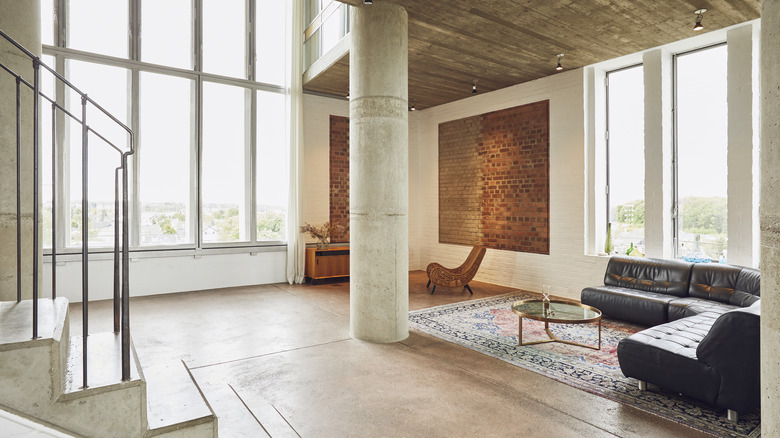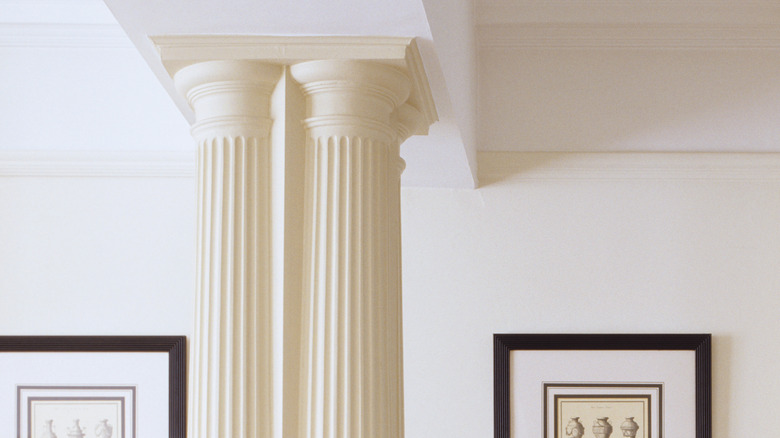Give That Random Pillar In Your Home A Functional Shelf With A Creative DIY
When life gives you lemons, make lemonade! This applies perfectly to architectural posts in living rooms, finished basements, and other inconvenient spots in your home. Whether they're structural or ornamental, lots of homes have these often awkward features. Instead of lamenting how they're in the way or how ugly they are, add charm to bulky structural columns by attaching shelves that won't leave permanent damage. One clever strategy uses two ratchet straps to hold shelving that can encircle a large cylindrical column. This is ideal for renters, or if you simply don't want to make permanent holes in your pillar.
To make the most of your own post or pillar, you'll need enough wood to go entirely around the circumference of the structure. If your post is square, you can get away with four pieces cut from a 1x12 board, one for each side. For circular columns, you'll need to purchase a large piece of plywood or medium density fiberboard (MDF). As for brackets, purchase two to four brackets for every 8 to 10 inches of shelf.
You'll also need wood screws, stain, and two heavy-duty ratchet straps. For tools, you'll need a level, a paintbrush, sandpaper, and a drill with a drill bit and screwdriver head. If you are cutting curved shelves, you'll also need a tool like a router or saw. Lastly, if you choose to hide the brackets in a more polished way, purchase a sheet of pliable MDF that will reach all the way around your pillar. Double-sided adhesive strips or a bit of durable cord or rope will also be necessary for holding the MDF in place.
Steps towards a new shelf for your post
Start with the wood cuts for your shelf. For square posts, cut four lengths about 1 foot longer than the width of the post. If you have a circular post, make two half-circle cuts of plywood with a cut in the middle that matches the curve of the post; the outer edge should extend about a foot away from the wall once you've hung the pieces. Here are some tips on the best way to cut circles in wood. Remember to wear gloves and safety glasses.
Loop one of the ratchet straps around the post and tighten it enough that it can hold the brackets lightly in place. Slip each bracket under the strap with the vertical edges pointing up and the bottom edge of the strap flush with the 90-degree bends in the brackets. Space the brackets so the weight of the shelf pieces will be evenly distributed. Before fully tightening the strap, use your level to check that your brackets are even. Then use the second ratchet strap to secure the ends of the brackets to the pillar.
Sand and stain your shelf pieces before screwing them to the brackets, and if you're using flexible MDF with your circular pillar, paint it a color close to matching the post or an accent color. If you choose to hang your shelf high enough that the underside is visible, attach the wood to the brackets through the top of the shelf. If you're hanging your shelf low enough that the underside won't show, attach the brackets to the wood from beneath. Wrap the pillar with the MDF and secure the ends.
Important considerations and troubleshooting when building shelves for a pillar
There are a few things to keep in mind when considering a shelf for your pillar or post. If your pillar has decorative features like ridges or molding, this may affect how well the ratchet straps grip the post. Test the brackets' hold before attaching the wood shelving. If you're not confident with how much weight the shelf can consistently hold, avoid placing heavy or breakable objects on it.
Also, tightening the straps enough for the shelf to be reliable may cause the brackets to dig into the post and leave indentations. If you're renting, you may want to test the surface of the post in a spot that won't be too visible. Attach one of the straps at the very top of the post, flush with the ceiling. Before tightening it fully, tuck a screw under the strap, preferably on a side of the post that is less visible than others. If the screw leaves an indentation after you've loosened the strap, the metal brackets would probably do the same.
To avoid this damage, you could opt to tighten the straps just enough for the shelf to hold lightweight things like non-breakable decor items. Alternatively, you could use felt furniture pads between the bracket and the pillar. In case the pads make the brackets less capable of holding a lot of weight, arrange your shelf with items that aren't very heavy or fragile. If your brackets do leave indentations, you can always patch the spots with plaster or spackle later. If you don't have any on hand, there are also some household materials you can substitute for spackle.

